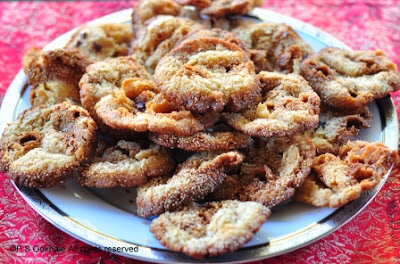This is a delicious fruit dessert. It is warm and perfect for a cold winter night. Add in a scoop of vanilla ice cream and it is the perfect dessert to satisfy your sweet tooth. Now, there are several recipes of apple crumble out there, however, when I wanted to make this, I turned to a recipe from America's Test Kitchen Cooking School Cookbook. I wanted a recipe which would taste great and have a crunchy crumble and knew that I could rely on this recipe. I needed to make it nut free, and the original recipe called for almonds, so I made a few substitutions and it turned out delicious. Best of all it could be eaten by everyone and I didn't have to worry about those with allergies.
For the crust
1 cup all purpose flour
1/4 cup sugar + 1 tbsp sugar
1/4 cup brown sugar, packed
1/8 tsp salt
7 tbsp butter, cut into cubes at room temperature
1/2 cup traditional rolled oats
2 tsp vanilla essence
For the filling
8 medium sized apples, peeled, cored and diced into 1/2 inch pieces
1/2 tsp cornstarch
4 tsp lemon juice
2/3 cup sugar
1/8 tsp salt
1/8 tsp nutmeg powder
1/8 tsp cinnamon powder
Method
Preheat the oven to a temperature of 350F. Place one rack in the middle of the oven and another baking rack at the lowest level in the oven.
In a large mixing bowl, mix together the lemon juice and cornstarch. Add in the apple pieces, sugar, salt, cinnamon and nutmeg powder. Toss all this together till the apple pieces are well coated. Pour this into a 8 inch square baking tin and cover it tightly with aluminium foil. Keep aside
Keep 1 tbsp of sugar aside. In a food processor, mix together the all purpose flour, salt, both sugars, and vanilla essence. Then add the butter pieces and 1/4 cup of rolled oats. Pulse it all together till the mixture comes together into lumps. Use a spatula to scrape the bowl down. Add the remainder of the 1/4 cup of rolled oats and pulse a couple of times till it is blended into the the mixture, but not completely powdered down.
Place this on a baking tray lined with parchment paper or a silicon mat. Shape it in a square similar to the size of the baking tin containing the apple crumble. It will be about 1/2 inch in thickness. Place this baking tray with the topping mixture onto the middle rack and the baking tin containing the apple mixture on the lower rack in the oven.
Bake these for 20 minutes. Turn the baking tray once by 180 degrees, so that the crust gets cooked evenly. The crust will be lightly browned at this time.
Remove both the baking tray and tin from the oven.
Increase the temperature of the oven to 375F.
Remove the foil covering the baking tin and then by lifting the mat/paper slide the crust onto the apple mixture. Sprinkle 1 tbsp of sugar on the top of the crust. Place this tin back into the oven on the lower rack and bake it for 25 minutes till the crust is browned and the apple mixture is bubbling.
Tips
If you do not have 8 apples, you can also substitute some pears instead.
You can use a spatula to break the crust and place it piece by piece onto the apple mixture, till the mixture is covered completely.







.JPG)








































.JPG)





